Lausanne
| Lausanne | ||
|---|---|---|
|
Aerial view of Lausanne | ||
| ||
 Lausanne | ||
|
Location of Lausanne 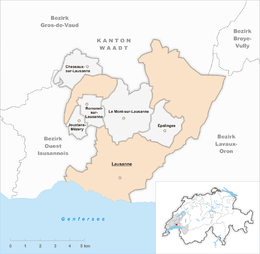 | ||
| Coordinates: 46°31.19′N 6°38.01′E / 46.51983°N 6.63350°ECoordinates: 46°31.19′N 6°38.01′E / 46.51983°N 6.63350°E | ||
| Country | Switzerland | |
| Canton | Vaud | |
| District | Lausanne | |
| Government | ||
| • Executive |
Municipalité with 7 members | |
| • Mayor |
Syndic (list) Grégoire Junod SPS/PSS (as of 2016) | |
| • Parliament |
Conseil communal with 100 members | |
| Area[1] | ||
| • Total | 41.38 km2 (15.98 sq mi) | |
| Elevation | 495 m (1,624 ft) | |
| Highest elevation (Jorat) | 929.4 m (3,049.2 ft) | |
| Lowest elevation (Lake Léman) | 372 m (1,220 ft) | |
| Population (Dec 2015[2]) | ||
| • Total | 135,629 | |
| • Density | 3,300/km2 (8,500/sq mi) | |
| Demonym(s) | French: Lausannois(e) | |
| Postal code | 1000–1018 | |
| SFOS number | 5586 | |
| Localities | Le Chalet-à-Gobet, Montblesson, Montheron, Ouchy, Vernand-Dessous, Vernand-Dessus, Vers-chez-les-Blanc | |
| Surrounded by | Bottens, Bretigny-sur-Morrens, Chavannes-près-Renens, Cheseaux-sur-Lausanne, Crissier, Cugy, Écublens, Épalinges, Évian-les-Bains (FR-74), Froideville, Jouxtens-Mézery, Le Mont-sur-Lausanne, Lugrin (FR-74), Maxilly-sur-Léman (FR-74), Montpreveyres, Morrens, Neuvecelle (FR-74), Prilly, Pully, Renens, Romanel-sur-Lausanne, Saint-Sulpice, Savigny | |
| Website |
www Profile (French), SFSO statistics | |
Lausanne (/loʊˈzæn/, French: [lozan], Italian: Losanna, Romansh: Losanna) is a city in the French-speaking part of Switzerland, and the capital and biggest city of the canton of Vaud. The city is situated on the shores of Lake Geneva (French: Lac Léman, or simply Le Léman).[3] It faces the French town of Évian-les-Bains, with the Jura Mountains to its north-west. Lausanne is located 62 kilometres (38.5 miles) northeast of Geneva.
Lausanne has a population (as of November 2015) of 146,372,[4] making it the fourth largest city in Switzerland, with the entire agglomeration area having 420,000 inhabitants (as of March 2015).[5] The metropolitan area of Lausanne-Geneva (including Vevey-Montreux, Yverdon-les-Bains, and foreign parts) was over 1.2 million inhabitants in 2000.[6]
Lausanne is a focus of international sport, hosting the International Olympic Committee (which recognizes the city as the "Olympic Capital" since 1994),[7] the Court of Arbitration for Sport and some 55 international sport associations.[8] It lies in a noted wine-growing region. The city has a 28-station metro system, making it the smallest city in the world to have a rapid transit system.
History
The Romans built a military camp, which they called Lousanna, at the site of a Celtic settlement, near the lake where currently Vidy and Ouchy are situated; on the hill above was a fort called 'Lausodunon' or 'Lousodunon' (The 'y' suffix is common to many place names of Roman origin in the region (e.g.) Prilly, Pully, Lutry, etc.).[9] By the 2nd century AD it was known as vikanor[um] Lousonnensium and in 280 as lacu Lausonio. By 400 it was civitas Lausanna and in 990 it was mentioned as Losanna.[10]
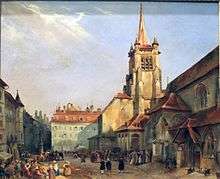
After the fall of the Roman Empire, insecurity forced the transfer of Lausanne to its current centre, a hilly site that is easier to defend. The city which emerged from the camp was ruled by the Dukes of Savoy and the Bishop of Lausanne. Then it came under Bern from 1536 to 1798 and a number of its cultural treasures, including the hanging tapestries in the Cathedral, were permanently removed. Lausanne has made a number of requests to recover them.
After the revocation of the Edict of Nantes in 1685, Lausanne became (along with Geneva) a place of refuge for French Huguenots. In 1729 a seminary was opened by Antoine Court and Benjamin Duplan. By 1750 ninety pastors had been sent back to France to work clandestinely; this number would rise to four hundred. Official persecution ended in 1787; a faculty of Protestant theology was established at Montauban in 1808, and the Lausanne seminary was finally closed on 18 April 1812.[11] During the Napoleonic Wars, the city's status changed. In 1803, it became the capital of a newly formed Swiss canton, Vaud under which it joined the Swiss Federation.[12]
Modern history and heritage
In 1964 the city hosted the 'Swiss National Exhibition',[13] displaying its newly found confidence to host major international events. From the 1950s to 1970s a large number of Italians, Spaniards and Portuguese immigrated, settling mostly in the industrial district of Renens and transforming the local diet.
The city has served as a refuge for European artists. While under the care of a psychiatrist at Lausanne, T. S. Eliot composed most of his 1922 poem The Wasteland ("by the waters of Leman I sat down and wept").[14] Hemingway also visited from Paris with his wife during the 1920s, to holiday. In fact, many creative people - such as Edward Gibbon, an historian, and Romantic era poets Shelley and Byron - have "sojourned, lived, and worked in Lausanne or nearby".[15]
The city has been traditionally quiet, but in the late 1960s and early 1970s a series of demonstrations took place that exposed tensions between young people and the police. Later demonstrations took place to protest against the high cinema prices, followed by protest against the G8 meetings in 2003.[16]
Geography
Topography
The most important geographical feature of the area surrounding Lausanne is Lake Geneva (Lac Léman in French). Lausanne is built on the southern slope of the Swiss plateau, with a difference in elevation of about 500 metres (1,640 ft) between the lakeshore at Ouchy and its northern edge bordering Le Mont-sur-Lausanne and Épalinges. Lausanne boasts a dramatic panorama over the lake and the Alps.
In addition to its generally southward-sloping layout, the centre of the city is the site of an ancient river, the Flon, which has been covered since the 19th century. The former river forms a gorge running through the middle of the city south of the old city centre, generally following the course of the present Rue Centrale, with several bridges crossing the depression to connect the adjacent neighbourhoods. Due to the considerable differences in elevation, visitors should make a note as to which plane of elevation they are on and where they want to go, otherwise they will find themselves tens of metres below or above the street which they are trying to negotiate. The name Flon is also used for the metro station located in the gorge.
The municipality includes the villages of Vidy, Cour, Ouchy, Mornex, Chailly, La Sallaz, Vennes, Montblesson, Vers-chez-les-Blanc, Montheron and Chalet-à-Gobet (871 m (2,858 ft)) as well as the exclave of Vernand.
Lausanne is located at the limit between the extensive wine-growing regions of Lavaux (to the east) and la Côte (to the west).
Lausanne has an area, as of 2009, of 41.38–41.33 square kilometers (15.98–15.96 sq mi) (depending on calculation method). Of this area, 6.64 km2 (2.56 sq mi) or 16.0% is used for agricultural purposes, while 16.18 km2 (6.25 sq mi) or 39.1% is forested. Of the rest of the land, 18.45 km2 (7.12 sq mi) or 44.6% is settled (buildings or roads), 0.05 km2 (12 acres) or 0.1% is either rivers or lakes and 0.01 km2 (2.5 acres) or 0.0% is unproductive land.[17]
Of the built-up area, industrial buildings made up 1.6% of the total area while housing and buildings made up 21.6% and transportation infrastructure made up 12.5%. Power and water infrastructure as well as other special developed areas made up 1.4% of the area while parks, green belts and sports fields made up 7.5%. Out of the forested land, all of the forested land area is covered with heavy forests. Of the agricultural land, 11.1% is used for growing crops and 4.2% is pastures. All the water in the municipality is in lakes.[17]
The municipality was part of the old Lausanne District until it was dissolved on 31 August 2006, and it became the capital of the new district of Lausanne.[18]
Climate
Lausanne has an average of 119.7 days of rain or snow per year and on average receives 1,153 mm (45.4 in) of precipitation. The wettest month is May during which time Lausanne receives an average of 117 mm (4.6 in) of rain. During this month there is precipitation for an average of 12.1 days. The driest month of the year is February with an average of 67 mm (2.6 in) of precipitation over 8.8 days.[19]
| Climate data for Pully (Lausanne) (1981–2010) | |||||||||||||
|---|---|---|---|---|---|---|---|---|---|---|---|---|---|
| Month | Jan | Feb | Mar | Apr | May | Jun | Jul | Aug | Sep | Oct | Nov | Dec | Year |
| Average high °C (°F) | 4.4 (39.9) |
5.6 (42.1) |
10.1 (50.2) |
14.0 (57.2) |
18.7 (65.7) |
22.4 (72.3) |
25.0 (77) |
24.4 (75.9) |
19.8 (67.6) |
14.6 (58.3) |
8.6 (47.5) |
5.3 (41.5) |
14.4 (57.9) |
| Daily mean °C (°F) | 1.2 (34.2) |
3.0 (37.4) |
6.6 (43.9) |
10.0 (50) |
14.4 (57.9) |
17.8 (64) |
20.3 (68.5) |
19.7 (67.5) |
15.8 (60.4) |
11.6 (52.9) |
6.1 (43) |
3.2 (37.8) |
10.9 (51.6) |
| Average low °C (°F) | 0.3 (32.5) |
0.7 (33.3) |
3.5 (38.3) |
6.4 (43.5) |
10.7 (51.3) |
13.8 (56.8) |
16.1 (61) |
15.9 (60.6) |
12.6 (54.7) |
9.1 (48.4) |
4.2 (39.6) |
1.4 (34.5) |
7.9 (46.2) |
| Average precipitation mm (inches) | 77 (3.03) |
67 (2.64) |
78 (3.07) |
87 (3.43) |
117 (4.61) |
112 (4.41) |
92 (3.62) |
110 (4.33) |
114 (4.49) |
113 (4.45) |
93 (3.66) |
92 (3.62) |
1,153 (45.39) |
| Average snowfall cm (inches) | 10.9 (4.29) |
14.3 (5.63) |
1.6 (0.63) |
0.2 (0.08) |
0.0 (0) |
0.0 (0) |
0.0 (0) |
0.0 (0) |
0.0 (0) |
0.0 (0) |
1.1 (0.43) |
7.0 (2.76) |
35.1 (13.82) |
| Average precipitation days (≥ 1.0 mm) | 10.1 | 8.8 | 10.2 | 9.8 | 12.1 | 10.4 | 9.0 | 9.5 | 8.8 | 10.1 | 10.2 | 10.7 | 119.7 |
| Average snowy days (≥ 1.0 cm) | 2.9 | 2.8 | 1.3 | 0.1 | 0.0 | 0.0 | 0.0 | 0.0 | 0.0 | 0.0 | 0.8 | 1.9 | 9.8 |
| Average relative humidity (%) | 78 | 73 | 68 | 66 | 67 | 66 | 65 | 68 | 73 | 78 | 78 | 78 | 72 |
| Mean monthly sunshine hours | 72 | 97 | 159 | 179 | 201 | 229 | 252 | 234 | 183 | 128 | 79 | 58 | 1,872 |
| Percent possible sunshine | 29 | 37 | 46 | 47 | 48 | 54 | 59 | 58 | 52 | 42 | 32 | 26 | 46 |
| Source: MeteoSwiss[19] | |||||||||||||
Politics
Coat of arms
The blazon of the municipal coat of arms is Gules, chief argent.[20]
Administrative divisions
The city is divided into 18 quartiers, or districts, sometimes composed of several neighborhoods. They are: Centre (1), Maupas/Valency (2), Sébeillon/Malley (3), Montoie/Bourdonnette (4), Montriond/Cour (5), Sous-Gare/Ouchy (6), Montchoisi (7), Florimont/Chissiez (8), Mousquines/Bellevue (9), Vallon/Béthusy (10), Chailly/Rovéréaz (11), Sallaz/Vennes/Séchaud (12), Sauvabelin (13), Borde/Bellevaux (14), Vinet/Pontaise (15), Bossons/Blécherette (16), Beaulieu/Grey/Boisy (17), and Les Zones foraines (90)
Government
The Municipality (la Municipalité) constitutes the executive government of the City of Lausanne and operates as a collegiate authority. It is composed of seven councilors (French: conseiller municipal/conseillère municipale), each presiding over a directorte. One of the memebers act as mayor (syndic). In the mandate period 2016–2021 (la législature) the Municipality is presided by Monsieur le Syndic Grégoire Junod. Directoral tasks, coordination measures and implementation of laws decreed by the Communal Council are carried by the Municipality. The regular election of the Municipality by any inhabitant valid to vote is held every five years. Any resident of Lausanne allowed to vote can be elected as a member of the Municipality. Since 14 April 2003, due to the constitution by canton of Vaud not only Swiss citizen have the right to vote and elect and being elected on communal level, but also foreigners with a residence permit of at least 10 years in Switzerland and 3 years in the canton of Vaud.[21] The current mandate period is from 1 June 2016 to 31 May 2021. The mayor is elected as such by a public election while the heads of the other departments are assigned by the collegiate. The executive body holds its meetings in the Town Hall (L'Hôtel de Ville), in the old city on Place de la Palud.[22]
As of 2016, Lausanne's Municipality is made up of three representatives of the PS (Social Democratic Party), and two members of PES (Green Party, of whom one is also the mayor), and one each of le Parti Ouvrier et Populaire Vaudois (POP) & gauche en mouvement (an alliance of the left parties POP (Parti Suisse du Travail - Parti Ouvrier et Populaire) and solidaritéS and indépendant.e.s), and PLR (Les Libéraux-Radicaux (PLR)), giving the left parties a very strong six out of seven seats. The last election was held on 13 March 2011.[23]
| Councilor (conseiller municipal/ conseillère municipale) | Party | Directorate (Direction de(s), since) of | elected since |
|---|---|---|---|
| Grégoire Junod[CM 1] | PS | Culture and Urban Development (Culture et dévelopment urbain, 2016) | 2011 |
| Pierre-Antoine Hildbrand | PLR | Security and Economy (Sécurité et économie, 2016) | 2016 |
| Oscar Tosato[CM 2] | PS | Sports and Social Cohesion (Sports et cohésion sociale, 2002) | 2001 |
| Natacha Litzistorf | PES | Housing, Environmental Development, and Building/Architecture (Logement, environnement et architecture, 2016) | 2016 |
| David Payot | POP & gauche en mouvement | Childhood, Youth, and Quarters (Enfance, jeunesse et quartiers, 2016) | 2016 |
| Florence Germond | PS | Finances and Mobility (Finances et mobilité, 2011) | 2011 |
| Jean-Yves Pidoux | PES | Industrial Services (Services industriels, 2006) | 2006 |
Simon Affolter is Town Chancellor (chancelier municipal) since for the Municipality.
Parliament
Le Conseil communal of Lausanne for the mandate period of 2016-2021
The Communal Council (Conseil communal) holds legislative power. It is made up of 100 members, with elections held every five years. The Communal Council decrees regulations and by-laws that are executed by the Municipality and the administration. The sessions of the Communal Council are public. Unlike members of the Municipality, members of the Communal Council are not politicians by profession, and they are paid a fee based on their attendance. Any resident of Lausanne allowed to vote can be elected as a member of the Communal Council. Since 14 April 2003, due to the constitution by canton of Vaud not only Swiss citizen have the right to vote and elect and being elected on communal level, but also foreigners with a residence permit of at least 10 years in Switzerland and 3 years in the canton of Vaud.[21] The Parliament holds its meetings in the Town Hall (Hôtel de Ville), in the old city on Place de la Palud.[24]
The last election of the Communal Council was held on 28 February 2016 for the mandate period (la législature) from 1 June 2016 to 31 May 2021. Currently the Communal Council consist of 33 members of the Social Democratic Party (PS), 21 Les Libéraux-Radicaux (PLR), 17 Green Party (PES), 12 Swiss People's Party (UDC), 11 Ensemble à Gauche (an alliance of the left parties POP (Parti Suisse du Travail - Parti Ouvrier et Populaire) and solidaritéS and indépendant.e.s), and 6 Le Centre (an alliance of Christian Democratic People's Party (PDC) and Green Liberal Party (pvl)).[25]
Elections
National Council
In the 2015 federal election for the Swiss National Council the most popular party was the PS which received 30.8% of the vote. The next three most popular parties were the PLR (18.6%), the Green Party (15.9%), and the UDC (15.4%). In the federal election, a total of 26,116 voters were cast, and the voter turnout was 41.0%.[26]
Demographics
Population
| Largest groups of foreign residents 2013[27] | ||
| Nationality | Amount | % total (foreigners) |
|---|---|---|
| 10,081 | 7.2 (17.2) | |
| 9,968 | 7.2 (17.0) | |
| 6,326 | 4.5 (10.8) | |
| 4,558 | 3.3 (7.8) | |
| 2,318 | 1.7 (4.0) | |
| 1,377 | 1.0 (2.4) | |
| 934 | 0.7 (1.6) | |
| 859 | 0.6 (1.5) | |
| 840 | 0.6 (1.4) | |
| 828 | 0.6 (1.4) | |
| 810 | 0.6 (1.4) | |
| 806 | 0.6 (1.4) | |
| 784 | 0.6 (1.3) | |
| 749 | 0.5 (1.3) | |
| 724 | 0.5 (1.2) | |
| 668 | 0.5 (1.1) | |
| 607 | 0.4 (1.0) | |
| 604 | 0.4 (1.0) | |
| 560 | 0.4 (1.0) | |
Lausanne has a population (as of December 2015) of 135,629.[28] As of 2013, 42% of the population were resident foreign nationals.[27] Over the last 10 years (1999–2009) the population has changed at a rate of 9.9%. It has changed at a rate of 8.3% due to migration and at a rate of 2.6% due to births and deaths.[29] The population of the greater Lausanne area (grand Lausanne) is 402,900 (as of December 2014).[5]
Of the population in the municipality, 58% or 80,828 have a Swiss citizenship, while 16,908 or 12.1% are from Lausanne and still lived there in December 2013. There were 27,653 or 19.8% who are from somewhere else in the same canton, while 36,276 or 26.0% have a Swiss citizenship in another canton. 58,9562 or 42.0% have a foreign citizenship.[4]
In 2000, most of the population spoke French (98,424 or 78.8%), with German being second most common (5,365 or 4.3%) and Italian being third (4,976 or 4.0%). There were 62 people who speak Romansh.[30]
In 2008 there were 840 live births to Swiss citizens and 623 births to non-Swiss citizens, and in same time span there were 862 deaths of Swiss citizens and 127 non-Swiss citizen deaths. Ignoring immigration and emigration, the population of Swiss citizens decreased by 22 while the foreign population increased by 496. There were 9 Swiss men and 57 Swiss women who emigrated from Switzerland. At the same time, there were 2230 non-Swiss men and 1802 non-Swiss women who immigrated from another country to Switzerland. The total Swiss population change in 2008 (from all sources, including moves across municipal borders) was an increase of 883 and the non-Swiss population increased by 2221 people. This represents a population growth rate of 2.6%.[31]
The age distribution, as of 2009, in Lausanne is; 11,818 children or 9.4% of the population are between 0 and 9 years old and 12,128 teenagers or 9.7% are between 10 and 19. Of the adult population, 21,101 people or 16.8% of the population are between 20 and 29 years old. 22,158 people or 17.6% are between 30 and 39, 18,016 people or 14.4% are between 40 and 49, and 13,940 people or 11.1% are between 50 and 59. The senior population distribution is 11,041 people or 8.8% of the population are between 60 and 69 years old, 8,277 people or 6.6% are between 70 and 79, there are 5,896 people or 4.7% who are between 80 and 89, and there are 1,171 people or 0.9% who are 90 and older.[32]

As of 2000, there were 58,100 people who were single and never married in the municipality. There were 48,990 married individuals, 7,797 widows or widowers and 10,027 individuals who are divorced.[30]
As of 2000 the average number of residents per living room was 0.64 which is about equal to the cantonal average of 0.61 per room.[29] In this case, a room is defined as space of a housing unit of at least 4 m2 (43.1 sq ft) as normal bedrooms, dining rooms, living rooms, kitchens and habitable cellars and attics.[33] About 6.5% of the total households were owner occupied, or in other words did not pay rent (though they may have a mortgage or a rent-to-own agreement).[34]

As of 2000, there were 62,258 private households in the municipality, and an average of 1.9 persons per household.[29] There were 31,205 households that consist of only one person and 2,184 households with five or more people.Out of a total of 63,833 households that answered this question, 48.9% were households made up of just one person and there were 306 adults who lived with their parents. Of the res of the households, there are 13,131 married couples without children, 11,603 married couples with children. There were 3,883 single parents with a child or children. There were 2,130 households that were made up of unrelated people and 1,575 households that were made up of some sort of institution or another collective housing.[30]
In 2000 there were 1,833 single family homes (or 23.1% of the total) out of a total of 7,925 inhabited buildings. There were 3,634 multi-family buildings (45.9%), along with 1,955 multi-purpose buildings that were mostly used for housing (24.7%) and 503 other use buildings (commercial or industrial) that also had some housing (6.3%). Of the single family homes 324 were built before 1919, while 153 were built between 1990 and 2000. The greatest number of single family homes (498) were built between 1919 and 1945. The most multi-family homes (933) were built before 1919 and the next most (906) were built between 1919 and 1945. There were 180 multi-family houses built between 1996 and 2000.[35]
In 2000 there were 69,383 apartments in the municipality. The most common apartment size was 3 rooms of which there were 22,408. There were 9,579 single room apartments and 7,388 apartments with five or more rooms. Of these apartments, a total of 61,056 apartments (88.0% of the total) were permanently occupied, while 6,840 apartments (9.9%) were seasonally occupied and 1,487 apartments (2.1%) were empty.[35] As of 2009, the construction rate of new housing units was 2.1 new units per 1000 residents.[29]
As of 2003 the average price to rent an average apartment in Lausanne was 1064.08 Swiss francs (CHF) per month (US$850, £480, €680 approx. exchange rate from 2003). The average rate for a one-room apartment was 597.46 CHF (US$480, £270, €380), a two-room apartment was about 792.33 CHF (US$630, £360, €510), a three-room apartment was about 1044.64 CHF (US$840, £470, €670) and a six or more room apartment cost an average of 2024.55 CHF (US$1620, £910, €1300). The average apartment price in Lausanne was 95.3% of the national average of 1116 CHF.[36] The vacancy rate for the municipality, in 2010, was 0.17%.[29]
Historic population
The historical population is given in the following chart:[10]

| Historic population data[10] | |||||||||||
|---|---|---|---|---|---|---|---|---|---|---|---|
| Year | Total population | French-speaking | German-speaking | Catholic | Protestant | Other | Jewish | Islamic | No religion given | Swiss | Non-Swiss |
| 13th century | 8,000-9,000 | ||||||||||
| 1650–1680 | c. 5,100 | ||||||||||
| 1698 | 6,204 | ||||||||||
| 1764 | 7,191 | ||||||||||
| 1798 | over 9,000 | ||||||||||
| 1813 | c. 13,000 | ||||||||||
| 1850 | 17,108 | 970 | 16,101 | 16,023 | 1,085 | ||||||
| 1870 | 25,845 | 3,527 | 22,596 | 22,353 | 4,167 | ||||||
| 1888 | 33,340 | 25,750 | 5,704 | 4,575 | 28,431 | 1,034 | 184 | 28,205 | 5,135 | ||
| 1900 | 46,732 | 35,509 | 6,627 | 9,364 | 36,659 | 1,450 | 473 | 37,231 | 9,501 | ||
| 1910 | 64,446 | 46,293 | 9,669 | 15,597 | 46,166 | 3,167 | 989 | 48,647 | 15,799 | ||
| 1930 | 75,915 | 58,691 | 11,080 | 16,868 | 56,300 | 2,901 | 818 | 65,231 | 10,684 | ||
| 1950 | 106,807 | 88,226 | 12,403 | 27,218 | 75,559 | 2,349 | 1,009 | 97,119 | 9,688 | ||
| 1970 | 137,383 | 101,555 | 11,964 | 54,993 | 75,093 | 11,670 | 1,394 | 669 | 2,056 | 106,229 | 31,154 |
| 1990 | 128,112 | 95,455 | 6,799 | 56,464 | 48,496 | 19,103 | 919 | 2,775 | 14,548 | 88,905 | 39,207 |
| 2000 | 124,914 | 98,424 | 5,365 | 47,225 | 36,084 | 16,149 | 849 | 7,501 | 21,080 | 80,213 | 44,701 |
Religion
From the Reformation in the 16th century, the city was mostly Protestant until the late 20th century, when it received substantial immigration, particularly from largely Catholic countries. Catholics now form a plurality of the city's population.
From the 2000 census, 47,225 people (37.8% of the population) were Roman Catholic, while 33,993 (27.2%) belonged to the Swiss Reformed Church. Of the rest of the population, there were 2,698 members of an Orthodox church (2.16%), there were 65 individuals (0.05%) who belonged to the Christian Catholic Church, and there were 4,437 individuals (3.55%) who belonged to another Christian church. There were 849 individuals (0.68%) who were Jewish, and 7,501 (6.00%) who were Muslim. There were 452 individuals who were Buddhist, 772 individuals who were Hindu and 343 individuals who belonged to another church. 21,080 (16.88%) belonged to no church, were agnostic or atheist, and 7,590 individuals (6.08%) did not answer the question.[30]
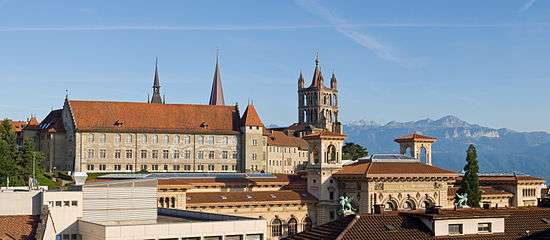
Crime
In 2014 the crime rate, of crimes listed in the Swiss Criminal Code, in Lausanne was 167.3 per thousand residents. During the same period, the rate of drug crimes was 49.5 per thousand residents, and the rate of violations of immigration, visa and work permit laws was 21 per thousand residents.[37]
Transport
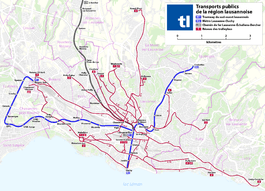
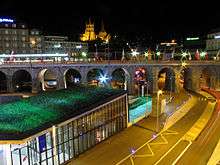
Lausanne is served by an extensive network of local, national and international public transport. National and international passenger trains of the Swiss Federal Railways depart from Lausanne railway station, which is also the hub of the Réseau Express Vaudois commuter rail system, and a stop on the city's metro. The metro and local buses are operated by Transports publics de la région lausannoise (TL), with many routes run using trolleybuses. Additional commuter trains are run by the Lausanne–Echallens–Bercher railway (LEB) from Lausanne-Flon station. Ships across Lake Geneva are provided by the Compagnie Générale de Navigation sur le lac Léman (CGN).
Lausanne became the first city in Switzerland to have a rubber-tyred metro system, with the m2 Line which opened in October 2008. The rolling stock is a shorter version of the one used on Paris Métro Line 14.[38] Further expansion of the system is planned, as is the re-introduction of trams.[39]
Lausanne is connected to the A1 motorway on its west side (Geneva - Zürich axis) and to the A9 on its north and east side (for transit with Italy and France); the interchange between these two motorways is on the north-west side of the city.
Lausanne Airport is located at Blécherette, and also houses a Boeing 737 Simulator.[40] The city is also directly linked by train to the Geneva International Airport, four times an hour, in 42min.
Economy
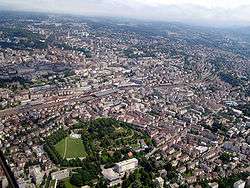
As of 2010, Lausanne had an unemployment rate of 8%. As of 2008, there were 114 people employed in the primary economic sector and about 25 businesses involved in this sector. 6,348 people were employed in the secondary sector and there were 698 businesses in this sector. 83,157 people were employed in the tertiary sector, with 6,501 businesses in this sector.[29]
There were 59,599 residents of the municipality who were employed in some capacity, of which females made up 47.4% of the workforce. In 2008 the total number of full-time equivalent jobs was 75,041. The number of jobs in the primary sector was 93, of which 56 were in agriculture, 34 were in forestry or lumber production and 3 were in fishing or fisheries. The number of jobs in the secondary sector was 6,057 of which 1,515 or (25.0%) were in manufacturing, 24 or (0.4%) were in mining and 3,721 (61.4%) were in construction. The number of jobs in the tertiary sector was 68,891. In the tertiary sector; 8,520 or 12.4% were in wholesale or retail sales or the repair of motor vehicles, 2,955 or 4.3% were in the movement and storage of goods, 4,345 or 6.3% were in a hotel or restaurant, 4,671 or 6.8% were in the information industry, 6,729 or 9.8% were the insurance or financial industry, 8,213 or 11.9% were technical professionals or scientists, 5,756 or 8.4% were in education and 14,312 or 20.8% were in health care.[41]
In 2000, there were 55,789 workers who commuted into the municipality and 19,082 workers who commuted away. The municipality is a net importer of workers, with about 2.9 workers entering the municipality for every one leaving. About 1.9% of the workforce coming into Lausanne are coming from outside Switzerland, while 0.1% of the locals commute out of Switzerland for work.[42] Of the working population, 40.9% used public transportation to get to work, and 35.1% used a private car.[29]
- Philip Morris International, a tobacco company, has its international headquarters in Lausanne.[43]
- Tetra Laval, a multinational packaging corporation, has its international headquarters in Lausanne.
- Nespresso, an operating unit of the Nestlé Group, based in Lausanne, Switzerland
Education
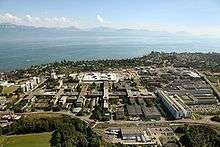
In Lausanne about 40,118 or (32.1%) of the population have completed non-mandatory upper secondary education, and 22,934 or (18.4%) have completed additional higher education (either university or a Fachhochschule). Of the 22,934 who completed tertiary schooling, 38.7% were Swiss men, 31.3% were Swiss women, 17.1% were non-Swiss men and 12.9% were non-Swiss women.[30]
In the 2009/2010 school year there were a total of 12,244 students in the Lausanne school district. In the Vaud cantonal school system, two years of non-obligatory pre-school are provided by the political districts.[44] During the school year, the political district provided pre-school care for a total of 2,648 children of which 1,947 children (73.5%) received subsidized pre-school care. The canton's primary school program requires students to attend for four years. There were 6,601 students in the municipal primary school program. The obligatory lower secondary school program lasts for six years and there were 5,244 students in those schools. There were also 399 students who were home schooled or attended another non-traditional school.[45]
Lausanne is home to a number of museums including; the Collection de l'art brut, the Espace Arlaud, the Fondation de l'Hermitage, the Musée cantonal d'archéologie et d'histoire, the Musée cantonal de géologie, the Musée cantonal de zoologie, the Cantonal Museum of Fine Arts, the Museum of Contemporary Design and Applied Arts, the Musée de l'Élysée and the Musée historique de Lausanne.[46] In 2009 the Collection de l'art brut was visited by 27,028 visitors (the average in previous years was 33,356). The Espace Arlaud was visited by 9,222 visitors (the average in previous years was 14,206). The Fondation de l'Hermitage was visited by 89,175 visitors (the average in previous years was 74,839). The Musée cantonal d'archéologie et d'histoire was visited by 14,841 visitors (the average in previous years was 15,775). The Musée cantonal de zoologie was visited by 30,794 visitors (the average in previous years was 30,392). The Musée cantonal de géologie was visited by 28,299 visitors (the average in previous years was 24,248). The Cantonal Museum of Fine Arts was visited by 26,456 visitors (the average in previous years was 26,384). The Museum of Contemporary Design and Applied Arts was visited by 28,554 visitors (the average in previous years was 22,879). The Musée de l'Élysée was visited by 36,775 visitors (the average in previous years was 37,757). The Musée historique de Lausanne was visited by 23,116 visitors (the average in previous years was 22,851).[46]
As of 2000, there were 12,147 students in Lausanne who came from another municipality, while 2,258 residents attended schools outside the municipality.[42]
Libraries
Lausanne is home to eight large libraries or collections of libraries. These libraries include: Cantonal and University Library of Lausanne, the library of the Swiss Federal Institute of Technology in Lausanne (EPFL), the libraries of the Réseau EPFL, the Bibliothèque municipale de Lausanne, the Haute école de travail social et de la santé (EESP), the HECV Santé, the Haute école de la santé La Source and the École cantonale d'art de Lausanne (ECAL). There was a combined total (as of 2008) of 3,496,260 books or other media in the libraries, and in the same year a total of 1,650,534 items were loaned out.[47]
Tertiary education
Lausanne enjoys some world class education and research establishments (see also Lausanne campus), including private schools, attended by students from around the world.
- Swiss Federal Institute of Technology in Lausanne (EPFL)
- University of Lausanne (UNIL)
- HEC Lausanne, Faculty of Business and Economics of the University of Lausanne
- University Hospital of Lausanne (CHUV), a hospital centre with associated research
- École hôtelière de Lausanne (EHL)
- École cantonale d'art de Lausanne (ECAL)
- International Institute for Management Development (IMD)
- Swiss Graduate School of Public Administration (IDHEAP)
- AISTS ("International Academy of Sports Science and Technology")
- Business School Lausanne (BSL)
- The Lausanne campus of the University of the Nations
- Pepperdine University maintains an international study campus in Lausanne
Primary and secondary schools
International schools:
Sights
Heritage sites of national significance
There are 46 buildings or sites that are listed as Swiss heritage site of national significance. Additionally, the entire old city of Lausanne and the Vernand-Dessus region are listed in the Inventory of Swiss Heritage Sites.[48]
- Religious Buildings: Notre-Dame Cathedral, Swiss Reformed Church of Saint-François, Swiss Reformed Church of Saint-Laurent and the Synagogue at Avenue de Florimont.
- Civic Structures: Former Hôpital at Rue Mercerie 24, Former Federal Tribunal, the Former Académie at Rue Cité-Devant 7, Casino de Montbenon, St-Maire Castle, Bois-de-Vaux Cemetery, Fondation de l’Hermitage and House de maître, Railway station, Beau-Rivage Palace, City Hall, Hôtel des Postes, Administration Building of André & Cie. S.A., Administration Building of the Vaudoise Assurances, Apartment and Office Building at Rue du Grand-Chêne 8, Les Bains de Bellerive, l’Estérel House, House at Chemin de Chandolin 4, the Mon-Repos estate at Parc de Mon-Repos, Olympic Museum and Archives of the International Olympic Committee, the vessels of the CGN (La Suisse (1910), Savoie (1914), Simplon (1920), Rhône (1927)), Pont Chauderon, the Vernand-Dessus rural site, Site de l’Expo 64 avec Théatre de Vidy, the Tour Bel-Air and the University Hospital of Lausanne (CHUV).
- Museums and Libraries: Former Residence of the Bishop of Lausanne which is now the Lausanne Museum of History, Bibliothèque des cèdres (former Bibliothèque des pasteurs), Beaulieu Castle and the Collection de l'art brut, Fondation Toms Pauli Collection de tapisseries and d’art textile, Galeries Saint-François, Musée de l'Élysée, Museum of Contemporary Design and Applied Arts (MUDAC), Cantonal Botanical Museum and Gardens, the Roman Museum, the Palais de Rumine with the Musée cantonal de géologie, Cantonal Museum of Zoology, Cantonal Museum of Fine Arts, Musée monétaire cantonal (Cabinet des médailles) and Musée cantonal d'archéologie et d'histoire.
- Archives: Archives of the Banque Vaudoise, Archives of the City of Lausanne, Archives of Énergie Ouest Suisse (EOS), the Radio Suisse Romande archives and the Federal Supreme Court of Switzerland with archives.
- Archeological sites: The Roman era/medieval hill-top city and the prehistoric settlement and Roman era Vicus of Vidy (Lousanna).

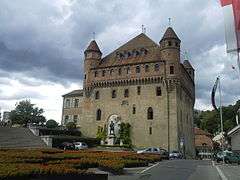
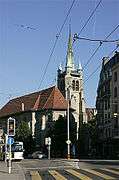 Swiss Reformed Church of Saint-François
Swiss Reformed Church of Saint-François Swiss Reformed Church of Saint-Laurent
Swiss Reformed Church of Saint-Laurent Fondation de l'Hermitage
Fondation de l'Hermitage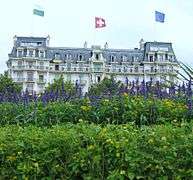 Hôtel Beau-Rivage Palace
Hôtel Beau-Rivage Palace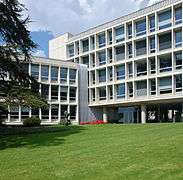 Administrative building of the Vaudoise Assurances
Administrative building of the Vaudoise Assurances
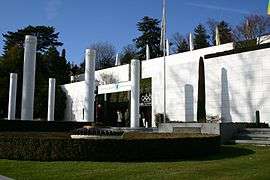 Olympic Museum and Archives of the International Olympic Committee
Olympic Museum and Archives of the International Olympic Committee- Ouchy waterfront
 Synagogue
Synagogue- The Sauvabelin Tower

Culture
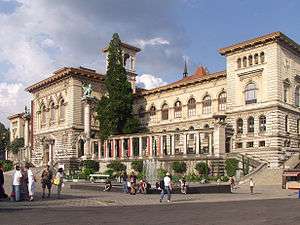
The Orchestre de chambre de Lausanne, the Lausanne Opera and the Ensemble vocal de Lausanne provide a diverse and rich musical life. The latter has been under the direction of Michel Corboz for many years.
In January, the Prix de Lausanne, a famous dance competition, takes place at the Palais de Beaulieu (the biggest theatre in Switzerland[49]) over a one-week period. The event attracts dancers and some of the big names in dance from all over the world.
The Swiss Film Archive is based in Lausanne and the city hosts film festivals such as the Festival cinémas d'Afrique and the Lausanne Underground Film and Music Festival. In addition to modern cinemas, the "Capitole" (in activity since 1929) is the biggest cinema in Switzerland (currently 867 seats).[50]
The town hosted the Eurovision Song Contest 1989. Each July, the Festival de la cité is held in the old part of town. Other music festivals include the Bach Festival, the Festival et concours Bach de Lausanne, which follows the Nuit de musées (museums' night) in the fall season.
Lausanne is also the home of the Béjart Ballet.
Monuments
- Cathedral (restored by Viollet-le-Duc)
- Saint-Maire Castle (Château Saint-Maire)
- Federal Supreme Court of Switzerland
- Town Hall [51]
Museums
Lausanne is also the site of many museums:
- Archizoom
- Musée Bolo
- Olympic Museum (Musée olympique)
- Musée de l'Élysée
- Fondation de l'Hermitage ("Hermitage Foundation")
- Collection of Outsider Art (Collection de l'art brut)
- Museum of Contemporary Design and Applied Arts (Musée de design et d'arts appliqués contemporains)
- Lausanne Museum of History (Musée historique de Lausanne)
- Espace Arlaud (French)
- Espace des inventions (French) ("Science Center for Kids")
- Fondation Claude Verdan (French) - Musée de la main ("Museum of the Hand")
- Vivarium de Lausanne (French)
- Cantonal Botanical Museum and Gardens (Musée et jardins botaniques cantonaux)
- Cantonal Museum of Money (Musée monétaire cantonal) (French) (formerly Cabinet cantonal des médailles - short presentation in English)
- Cantonal Museum of Archeology and History (Musée cantonal d'archéologie et d'histoire) (French) short presentation in English
- Cantonal Museum of Fine Arts (Musée cantonal des beaux-arts)
- Cantonal Museum of Zoology (Musée cantonal de zoologie)
- Cantonal Museum of Geology (Musée cantonal de Géologie) (French)
- Musée romain de Lausanne-Vidy ("Lausanne-Vidy Roman Museum")
Art galleries
Main contemporary art galleries:
- Galerie Lucy Mackintosh
- Dubner Moderne
- Synopsism (French)
- Espace Saint-François (French)
Art centers or artist-run galleries:
- Circuit (French)
- Galerie Galerie 1m3
- Doll espace d'art contemporain (French)
Music
- Contemporary composer Leonardo Balada's Symphony No. 4 is subtitled 'Lausanne'.
- Igor Stravinsky's L'Histoire du Soldat was premiered in Lausanne in September 1918.
Sports

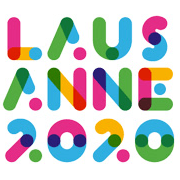
Sporting activities are very popular in Lausanne and is home to the IOC, with water sports available on the nearby lake and mountaineering in the nearby mountains. Cycling is also a popular pastime, with the vineyards in the surrounding hills providing spectacular views and challenging routes. There is an annual track and field meeting (Athletissima), road running through the city (the 20 km (12 mi) of Lausanne), the Tour de Romandie road cycling race, Marathon of Lausanne and triathlon competition, among other sports events. The two most important sports are ice hockey and football. Lausanne will host the 2020 Winter Youth Olympics.[52]
- Local
- Lausanne Hockey Club
- Lausanne-Sport Football Club
- Lausanne-Sports Aviron Rowing Club
- Lausanne Sharks American Football Club
- NSFL Non Professional Swiss Romand American Football Federation
- Federation of Swiss Bandy
- Stade Lausanne Rugby Club[53]
- Lausanne University Club Rugby
- Lausanne Frisbee[54]
- Swiss Power Wrestling, Professional Wrestling school[55]
- International
- International Olympic Committee Headquarters
- Court of Arbitration for Sport Headquarters
- International Hockey Federation Headquarters
- International Table Tennis Federation Headquarters
- Fédération Aéronautique Internationale (FAI) The World Air Sports Federation
- Fédération Equestre Internationale (FEI) The international governing body for equestrian
- Fédération Internationale des Sociétés d'Aviron (FISA) The international governing body for rowing
- Fédération Internationale d'Escrime (FIE) The international governing body for fencing
- Fédération Internationale de Tir à l'Arc (FITA) The international governing body for archery
- Fédération Internationale du Sport Universitaire (FISU) The international governing body for university sports
- International Baseball Federation
- International Swimming Federation
- International Skating Union
- Fédération Internationale de Volleyball (FIVB)
- International Triathlon Union (ITU)
- International Wushu Federation (IWUF)[56]
Notable people

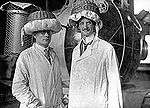
Lausanne is the birthplace of:
- David Bennent, actor
- Metropolitan Anthony (Bloom) of Sourozh, Russian Orthodox ecclesiastic located in Britain
- François-Louis David Bocion, artist and teacher
- Ernest Boiceau (1881-1950), artist and designer
- Marius Borgeaud, artist
- Hélène Boschi, pianist,
- Johann Ludwig Burckhardt, traveler and orientalist
- Alejo Carpentier, Cuban-French writer
- Stéphane Chapuisat, footballer
- Albert Chavannes, philosopher
- Benjamin Constant, thinker, writer and politician
- Aloise Corbaz, outsider artist
- Charles Dutoit, conductor
- Egon von Furstenberg, fashion designer
- Eugène Grasset, decorative artist
- Dominique Lévy, art dealer[57]
- Bertrand Piccard, psychiatrist and balloonist
- Charles-Ferdinand Ramuz, writer
- Ubolratana Rajakanya, Thai princess
- Théophile Steinlen, Art Nouveau painter and printmaker
- James Thiérrée, actor
- Elizabeth Thompson (Lady Butler), British painter
- Bernard Tschumi, contemporary architect, writer, and educator
- Nanos Valaoritis Greek poet
- Félix Vallotton, post-impressionist painter
- Vincent Perez, film actor and director
- Stanislas Wawrinka, tennis player
- Jocelyn Wildenstein, Manhattan socialite and ex-wife of the late Alec N. Wildenstein
- Ludovic Magnin, footballer
Notable residents:
- Bhumibol Adulyadej, late king of Thailand was educated at the École nouvelle de la Suisse romande
- Pierre Amoyal, Paris-born violinist; professor at Lausanne Conservatory
- Jean Anouilh, French dramatist
- Ingvar Kamprad, founder of IKEA
- Alice Bailly, Swiss painter and multimedia artist
- Maurice Béjart, choreographer
- Lorik Cana, professional footballer for Albania and Marseille
- Capucine, French actress and model
- Coco Chanel, fashion designer
- Pierre de Coubertin, French baron and founder of the International Olympic Committee
- Jean-Pascal Delamuraz, Swiss politician
- Helen of Greece and Denmark, Queen Mother of Romania
- Victoria Eugenia of Battenberg, Queen of Spain
- Peter Carl Fabergé, Russian jeweller
- Edward Gibbon, British historian
- Gloria Guinness, socialite and writer.
- Oswald Heer, Swiss geologist and naturalist
- Stéphane Lambiel, men's figure skater, Olympic silver medalist and 2-time world champion
- Sébastien Loeb, French rally driver
- Carl Gustaf Emil Mannerheim, Finnish president and field marshal
- James Mason, English actor
- Fernand Melgar, Swiss actor
- Jô Soares, Brazilian humorist
- Waldemar Mordecai Haffkine, Ukrainian bacteriologist
- Paloma Picasso, Fashion designer
- Auguste Piccard, Swiss physicist, inventor and explorer
- George Sanders, English actor
- Albin Schram, renowned manuscript collector
- Georges Simenon, Belgian writer
- Jon Steele, American-born author
- Han Suyin, China-born writer
- Karol Szymanowski, Polish composer
- Eugène Viollet-le-Duc, French architect
- Pierre Viret, Swiss reformed theologian
- Serge Voronoff, surgeon buried in Lausanne
See also
- Franco-Provençal language
- Eurovision Song Contest 1989
- International Academy of Sport Science and Technology (AISTS)
- Lac de Sauvabelin, Tour de Sauvabelin
- Beau-Rivage Palace
- Scots Kirk, Lausanne (Church of Scotland)
- List of mayors of Lausanne
- Lausanne Conference, 1949
- Treaty of Lausanne
Notes and references
- ↑ Arealstatistik Standard - Gemeindedaten nach 4 Hauptbereichen
- ↑ Swiss Federal Statistical Office - STAT-TAB, online database – Ständige und nichtständige Wohnbevölkerung nach institutionellen Gliederungen, Geburtsort und Staatsangehörigkeit (German) accessed 30 August 2016
- ↑ "03 - Suisse sud-ouest". Swiss National Map 1:200 000 - Switzerland on four sheets. Federal Office of Topography, swisstopo, Swiss Federal Department of Defence, Civil Protection and Sport. 2009. Retrieved 17 April 2014.
- 1 2 "Population totale selon l'origine, 1979-2013" (XLS). Scris.vd.ch (Statistics) (in French). Contrôle des Habitants de la Ville de Lausanne / StatVD, canton de Vaud. 23 January 2014. Retrieved 8 August 2014.
- 1 2 "Population size and population composition – Data, indicators – Agglomerations: Permanent resident population in urban and rural areas". Bfs.admin.ch (Statistics). Federal Statistical Office, Neuchâtel, Swiss Federal Administration. 2015. Retrieved 1 September 2015.
- ↑ "Office fédéral du développement territorial ARE – B3: Les aires métropolitaines" (PDF). www.are.admin.ch (in French, German, and Italian). Federal Office for Spatial Development ARE. 7 June 2006. p. 4. Retrieved 17 April 2014.
- ↑ "Welcome to International Sports Federations". International Sports Federations. Retrieved 27 September 2009.
- ↑ Kucera, Andrea (28 April 2015). "Lausanne – Hauptstadt des Sports". NZZ. Retrieved 28 April 2015.
- ↑ Lousonna in German, French and Italian in the online Historical Dictionary of Switzerland.
- 1 2 3 Lausanne in German, French and Italian in the online Historical Dictionary of Switzerland.
- ↑ Lasserre, Claude (1997). Le séminaire de Lausanne, 1726-1812 : instrument de la restauration du protestantisme français : étude historique fondée principalement sur les documents inédits. Bibliothèque historique vaudoise, no 112 (in French). Lausanne: Bibliothèque historique vaudoise. ISBN 978-2-88454-112-1. OCLC 39222660. Also OCLC 39228676
- ↑ Lausanne District 1313-2006 in German, French and Italian in the online Historical Dictionary of Switzerland.
- ↑ "Lausanne 1964: Two ideas, one Expo". Swiss National Exhibitions - Expo-Archive. swissinfo/Swiss Radio International (SRI). Retrieved 27 September 2009.
- ↑ "The Waste Land - Modernism Lab Essays". Modernism.research.yale.edu. 24 March 2009. Retrieved 18 January 2016.
- ↑ "The Fourteenth International Hemingway Society Conference : Hemingway's Extreme Geographies" (PDF). Unil.ch. Retrieved 18 January 2016.
- ↑ Reuters, ed. (2 June 2003). "Anti-G8 protests turn violent in Switzerland". Times of Malta. Retrieved 18 January 2016.
- 1 2 Swiss Federal Statistical Office-Land Use Statistics 2009 data. (German) Retrieved 25 March 2010.
- ↑ Nomenklaturen – Amtliches Gemeindeverzeichnis der Schweiz. (German) Retrieved 4 April 2011.
- 1 2 "Climate normals Pully (Reference period 1981−2010)" (PDF). Zurich Airport, Switzerland: Swiss Federal Office of Metreology and Climatology, MeteoSwiss. 2 July 2014. Retrieved 3 April 2015.
- ↑ "Lausanne commune (Vaud canton, Switzerland)". Crwflags.com. Retrieved 18 January 2016.
- 1 2 "Qui peut voter?" (official site) (in French). Geneva, Switzerland: Secrétariat municipal, Ville de Lausanne. Retrieved 1 November 2015.
- ↑ "Municipalité" (official site) (in French). Lausanne, Switzerland: Hôtel de Ville de Lausanne. Retrieved 2016-11-17.
- 1 2 "Composition de laMunicipalité: Composition des directions pour la législature 2016-2021" (official site) (in French). Lausanne, Switzerland: Hôtel de Ville de Lausanne. Retrieved 2016-11-17.
- ↑ "Conseil communal" (official site) (in French). Geneva, Switzerland: Conseil communal, Ville de Lausanne. Retrieved 1 November 2015.
- ↑ "Conseil communal: résultats:Répartition des sièges, bilan final" (official site) (in French). Lausanne, Switzerland: Conseil communal, Ville de Lausanne. Retrieved 30 March 2016.
- ↑ "Nationalratswahlen 2015: Stärke der Parteien und Wahlbeteiligung nach Gemeinden" (XLS) (official statistics) (in German and French). Neuchâtel, Switzerland: Swiss Federal Statistical Office. 4 March 2016. Retrieved 2016-08-03.
- 1 2 "Population totale par région du monde et selon la nationalité, 1979-2013" (XLS). Scris-lausanne.vd.ch/LS_pop_residante (Statistics) (in French). Contrôle des Habitants de la Ville de Lausanne / StatVD, canto de Vaud. 23 January 2014. Retrieved 8 August 2014.
data from December 2013
- ↑ Swiss Federal Statistical Office - STAT-TAB, online database – Ständige und nichtständige Wohnbevölkerung nach institutionellen Gliederungen, Geburtsort und Staatsangehörigkeit (German) accessed 30 August 2016
- 1 2 3 4 5 6 7 Swiss Federal Statistical Office. Retrieved 21 June 2011.
- 1 2 3 4 5 STAT-TAB Datenwürfel für Thema 40.3 - 2000. (German) Retrieved 2 February 2011.
- ↑ Swiss Federal Statistical Office - Superweb database - Gemeinde Statistics 1981-2008. (German) Retrieved 19 June 2010.
- ↑ Canton of Vaud Statistical Office. (French) Retrieved 29 April 2011.
- ↑ Eurostat. "Housing (SA1)". Urban Audit Glossary (PDF). 2007. p. 18. Retrieved 12 February 2010.
- ↑ Urban Audit Glossary p. 17.
- 1 2 Swiss Federal Statistical Office STAT-TAB - Datenwürfel für Thema 09.2 - Gebäude und Wohnungen. (German) Retrieved 28 January 2011.
- ↑ Swiss Federal Statistical Office-Rental prices 2003 data. (German) Retrieved 26 May 2010.
- ↑ Statistical Atlas of Switzerland. Retrieved 5 April 2016.
- ↑ Lambert, Anthony (2013). Switzerland without a Car (5 ed.). Bradt Travel Guides. p. 258. ISBN 978-1841624471.
- ↑ "Les Axes forts - Site officiel de la Ville de Lausanne". City of Lausanne. Retrieved 18 August 2014.
- ↑ "JMS Boeing 737 Simulator". Thebigboss.ch. Retrieved 26 March 2013.
- ↑ Swiss Federal Statistical Office STAT-TAB Betriebszählung: Arbeitsstätten nach Gemeinde und NOGA 2008 (Abschnitte), Sektoren 1-3. (German) Retrieved 28 January 2011.
- 1 2 Swiss Federal Statistical Office - Statweb. (German) Retrieved 24 June 2010.
- ↑ "PMI.com homepage". Philipmorrisinternational.com. Retrieved 18 January 2016.
- ↑ "STATISTIQUE VAUD - Généralités : Organigramme". Scris.vd.ch. Retrieved 18 January 2016.
- ↑ Canton of Vaud Statistical Office - Scol. obligatoire/filières de transition. (French) Retrieved 2 May 2011.
- 1 2 Canton of Vaud Statistical Office - Fréquentation de quelques musées et fondations, Vaud, 2001-2009. (French) Retrieved 2 May 2011.
- ↑ Swiss Federal Statistical Office, list of libraries. (German) Retrieved 14 May 2010.
- ↑ "Kantonsliste A-Objekte". KGS Inventar (in German). Federal Office of Civil Protection. 2009. Retrieved 25 April 2011.
- ↑ (French) Mathieu Signorell, "Beaulieu lâche les congrès pour les infirmiers après l'échec de Taoua", 24 heures, Saturday 14 February 2015.
- ↑ "Le Capitole". Lecapitole.ch. Retrieved 18 January 2016.
- ↑ https://web.archive.org/web/20120211130547/http://www.lausanne.ch/view.asp?docId=27749&domId=64350&language=E. Archived from the original on 11 February 2012. Retrieved 5 February 2016. Missing or empty
|title=(help) - ↑ Goddard, Emily (12 July 2013). "Swiss President Maurer "very excited" about Youth Olympic bid as Lausanne launches official application". Insidethegames.biz. Retrieved 18 January 2016.
- ↑ https://web.archive.org/web/20150705010723/http://www.stadelausannerugby.com/. Archived from the original on 5 July 2015. Retrieved 5 February 2016. Missing or empty
|title=(help) - ↑ https://web.archive.org/web/20121028162130/http://www.flyhigh.ultimate.ch/fr/Accueil.html. Archived from the original on 28 October 2012. Retrieved 5 February 2016. Missing or empty
|title=(help) - ↑ https://web.archive.org/web/20071116043149/http://www.lausanne.ch/view.asp?DocId=27899. Archived from the original on 16 November 2007. Retrieved 5 February 2016. Missing or empty
|title=(help) - ↑ http://www.iwuf.org/iwuf/
- ↑ "Dominique Levy". Dominique-levy.com. Retrieved 8 May 2014.
Bibliography
- Published in the 19th century
- Switzerland. Coblenz: Karl Baedeker. 1863.
- Published in the 20th century
- "Lausanne", Switzerland, Together with Chamonix and the Italian Lakes (26th ed.), Leipzig: Karl Baedeker, 1922, OCLC 4248970
External links
| Wikimedia Commons has media related to Lausanne. |
- City of Lausanne, official site
- The official tourism homepage of Lausanne
- Map of Lausanne
- Map of public transport
- Lausanne in German, French and Italian in the online Historical Dictionary of Switzerland.
 Lausanne travel guide from Wikivoyage
Lausanne travel guide from Wikivoyage
| Preceded by Dornbirn, Austria (2007) |
World Gymnaestrada host city 2011 |
Succeeded by Helsinki, Finland (2015) |



